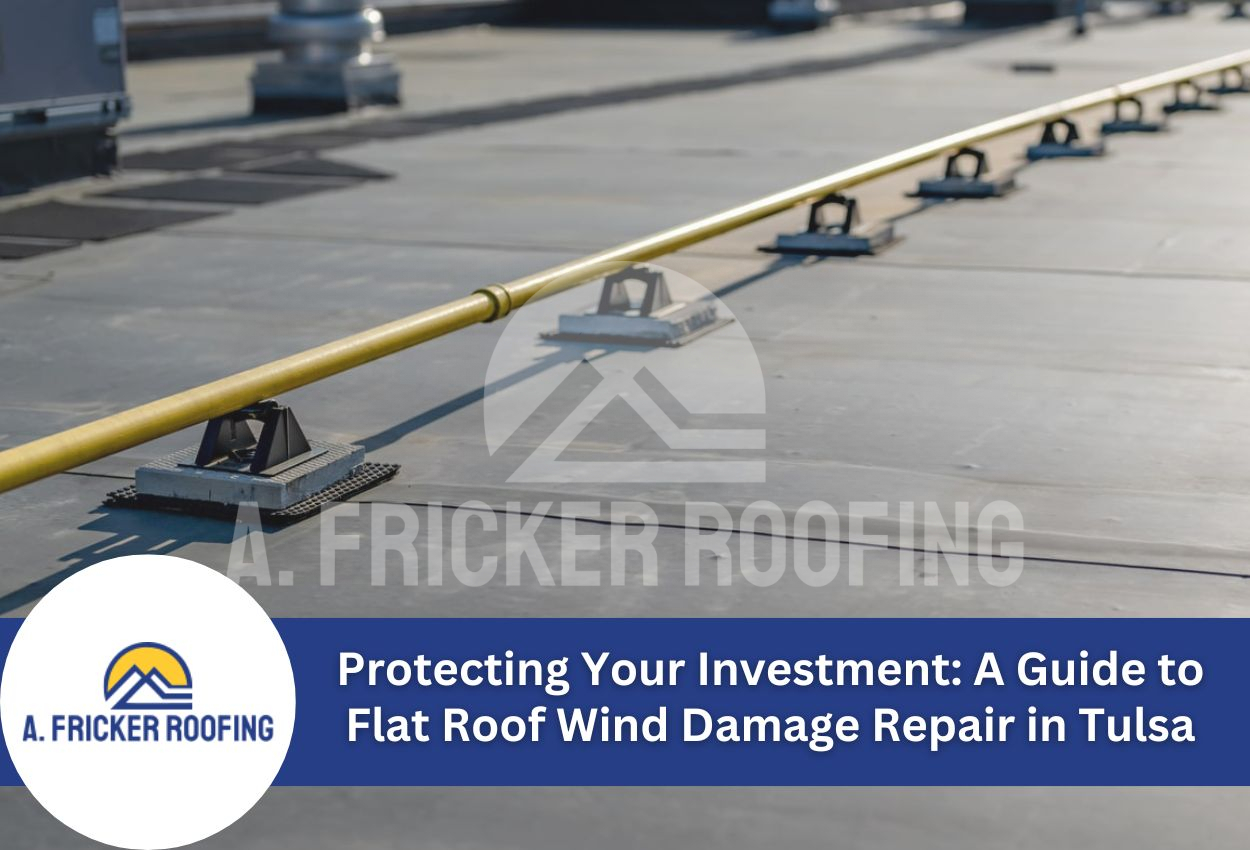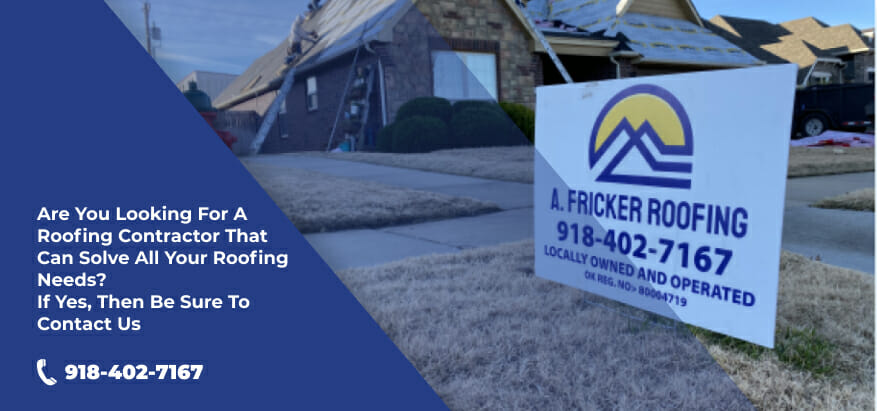Tulsa property owners face unique challenges when it comes to maintaining flat roofs in Oklahoma’s unpredictable weather. Wind damage represents one of the most significant threats to flat roofing systems, often causing issues that can quickly escalate from minor concerns to major structural problems. When high winds strike the Tulsa area, commercial and residential flat roofs are particularly vulnerable to uplift forces that can compromise membrane integrity, loosen flashing, and create entry points for water infiltration.
The consequences of unaddressed wind damage extend beyond immediate leaks. Even seemingly minor wind-related issues can lead to insulation degradation, decreased energy efficiency, and eventually, complete roof system failure.
Identifying wind damage early is key to preventing costly repairs. Common indicators include loose or missing roofing materials, bubbling or blistering of the membrane surface, separated seams, and damaged flashing around roof penetrations or edges. After severe windstorms, emergency flat roof assessments become essential, particularly for commercial properties where business operations depend on structural integrity. Professional roofing contractors in Tulsa have the expertise to detect subtle wind damage that untrained eyes might miss.
Identifying Wind Damage on Your Flat Roof: Warning Signs You Shouldn’t Ignore
Spotting wind damage on your flat roof early can save Tulsa property owners thousands in repair costs. After a windstorm passes through, take time to inspect your roof from ground level for visible signs of trouble. Look for the roofing membrane lifting at the edges where wind often begins its attack on flat roofing systems. Punctures from wind-blown debris, displaced gravel, and torn or loose flashings around vents and HVAC units are immediate red flags that require attention.
While some damage is visible from the ground, professional roofers utilize specialized assessment techniques to uncover hidden issues. Using infrared scanning, experienced Tulsa contractors can detect moisture trapped beneath the membrane, which is a common occurrence after intense wind that might otherwise go unnoticed. They’ll also check for subtle membrane separation along seams where wind uplift forces may have compromised adhesion without causing obvious visual damage.
Professionals also inspect the roof’s drainage system, as wind-blown debris often creates blockages that lead to ponding water. They’ll examine the substrate for signs of flexing or movement that indicates the wind has compromised structural integrity. Even small punctures can allow moisture penetration that degrades insulation and decking over time. For commercial buildings in particular, these hidden issues can develop into major problems if left unaddressed after Tulsa’s seasonal windstorms.
Emergency Response: First Steps After Wind Damages Your Flat Roof
When high winds damage your flat roof in Tulsa, taking immediate action can prevent a bad situation from becoming worse. Start by ensuring everyone’s safety by staying out of areas that show signs of structural damage, such as sagging ceilings or water intrusion. Once safe, use tarps to cover damaged sections, securing them with lumber or sandbags rather than nails that could create additional punctures. Remove standing water where possible using a shop vacuum to prevent further membrane deterioration and water infiltration.
Proper documentation is critical for insurance claims. Take comprehensive photos of all visible damage from multiple angles, capturing wide shots of the entire roof and close-ups of specific damaged areas. Document the date and approximate time of the windstorm and gather local weather reports confirming wind speeds. Create a detailed inventory of damaged business equipment or personal property affected by leaks. Save all receipts for emergency measures taken, as these expenses may be reimbursable.
Contact a qualified Tulsa roofing contractor specialized in flat roof systems for emergency assessment before making permanent repairs. They can install professional-grade temporary solutions that better protect your property while developing a comprehensive repair plan. Remember that reinforcing your flat roof against future wind events should be part of your repair strategy, potentially including enhanced attachment methods, improved flashing details, and wind-rated materials appropriate for Tulsa’s weather patterns.
Professional Repair Techniques for Wind-Damaged Flat Roofing Systems
Restoring a wind-damaged flat roof requires specific techniques tailored to different roofing materials. For EPDM rubber roofs, repairs typically involve cleaning damaged areas with appropriate solvents before applying specialized adhesives and patches. TPO membranes, increasingly popular in Tulsa commercial buildings, require hot-air welding to properly seal damaged seams and restore waterproof integrity. Modified bitumen systems often need torch-applied patches that integrate seamlessly with the existing membrane, while BUR repairs involve multiple layers of bitumen and reinforcing fabrics.
The professional repair process follows systematic steps regardless of the type of material. It begins with a thorough inspection to identify all wind damage, including hidden issues beneath the surface. Next comes material removal and preparation, where damaged sections are carefully cut out and the substrate is examined for structural integrity. Proper moisture mitigation follows, as trapped water can compromise repairs. The application of appropriate materials comes next, using manufacturer-specified techniques to ensure that the installation complies with warranty requirements. Finally, quality control inspections verify watertight seals and proper adhesion.
Tulsa roofing professionals emphasize the importance of comprehensive repairs rather than spot fixes after wind events. This approach not only addresses visible damage, but it also reinforces vulnerable areas to prevent future failures during Oklahoma’s strong storm seasons. Professional repairs also incorporate upgraded attachment methods that improve wind uplift resistance, particularly along roof perimeters and corners where wind forces concentrate.
Preventing Future Wind Damage: Reinforcement Strategies for Flat Roofs
Proactive reinforcement is the best defense against Tulsa’s unpredictable wind patterns. For commercial and residential flat roofs, structural reinforcement begins with improving membrane attachment. Professional roofers can upgrade adhesion methods by applying high-performance bonding agents that create stronger connections between the membrane and substrate. Mechanical fastening systems provide another layer of security, with specialized plates and screws that anchor the roofing system more firmly against uplift forces. Securing the edge of the perimeter is also particularly crucial, as research shows wind damage typically begins along roof edges where pressure differences are greatest.
Regular maintenance significantly extends wind resistance performance. Seasonal inspections should address membrane adhesion, sealant integrity, and drainage function. After each major windstorm, prompt assessment allows for minor adjustments before small issues develop into major vulnerabilities. By implementing these reinforcement strategies, Tulsa property owners can substantially reduce the risk of wind-related damage and extend the service life of their flat roofing systems throughout Oklahoma’s challenging weather conditions.
Commercial Considerations: Specialized Approaches for Business Properties
Commercial flat roofs in Tulsa face unique challenges when impacted by wind damage. Unlike residential properties, business facilities cannot afford extended downtime during repairs without significant financial consequences. When windstorms compromise a commercial flat roof, operations may need to stop, inventory can be damaged, and customer confidence might waver. This makes specialized repair essential for business property owners who need swift, effective solutions that reduce operational disruptions while ensuring long-term protection.
Business-focused flat roof repair strategies begin with rapid response teams capable of implementing temporary solutions that allow operations to continue during more comprehensive repairs. Professional Tulsa roofing contractors offer phased repair schedules that work around business hours, sectional repairs that keep portions of the facility functional, and expedited material procurement to reduce project timelines. These specialized approaches often include temporary weather protection systems that shield sensitive equipment and inventory during the repair process.
For commercial property owners concerned about recurring storm damage, several budget-conscious reinforcement options delivera strong return on investment. Enhanced membrane attachment systems using increased fastener density at perimeters cost relatively little but significantly improve wind uplift resistance. Installing properly engineered paver systems provides both ballast and protection against wind-borne debris. Upgrading to wind-rated edge metal systems prevents the edge lifting that initiates many flat roof failures during Tulsa’s high wind events. These targeted investments in vulnerable areas provide commercial property owners with cost-effective protection against the business disruption that wind damage inevitably brings.
Selecting the Right Flat Roof Repair Professional in Tulsa
Finding a qualified flat roof specialist to address wind damage requires careful consideration. Start by verifying essential credentials, such as manufacturer certifications from major flat roofing material producers like Firestone, GAF, or Carlisle. These certifications indicate the contractor has received specialized training in proper installation and repair techniques specific to flat roofing systems. Additionally, check for state licensing, adequate insurance coverage, and memberships in professional organizations like the National Roofing Contractors Association.
Experience specifically with wind damage repair is crucial when selecting a professional as well. Ask potential contractors about their history handling storm-damaged flat roofs and request references from similar commercial or residential projects. Qualified specialists should readily discuss their approach to detecting hidden wind damage through comprehensive inspection protocols. They should explain their methodology for reinforcing vulnerable areas against future wind uplift and demonstrate knowledge of local building codes that govern flat roof installations in Tulsa’s wind zones.
During your contractor interviews, ask about warranty protection for repairs. Reputable professionals offer workmanship guarantees beyond manufacturer material warranties. Ask specific questions about their emergency response capabilities for future windstorms, their approach to documenting damage for insurance claims, and their strategies for minimizing business disruption during repairs. The right flat roof specialist will provide clear, detailed proposals outlining their findings, recommended repair methods, and preventative measures to strengthen your roof against Tulsa’s seasonal high winds.
Choose A. Fricker Roofing and Waterproofing for Expert Wind Damage Repairs
If your flat roof has recently suffered wind damage, don’t wait for minor issues to become major expenses. At A. Fricker Roofing and Waterproofing, we specialize in quickly and efficiently repairing wind damage to flat roofs, ensuring your property is protected against future storms. Our team uses the latest techniques and materials suited for Tulsa’s unique climate to deliver durable, long-lasting repairs.
Understanding the urgency of these situations, we provide prompt service to assess and address any damage caused by wind. Don’t risk further damage to your property by putting off repairs, call us now at (918) 402-7167 to schedule a professional assessment and get your roof back to its best condition.

